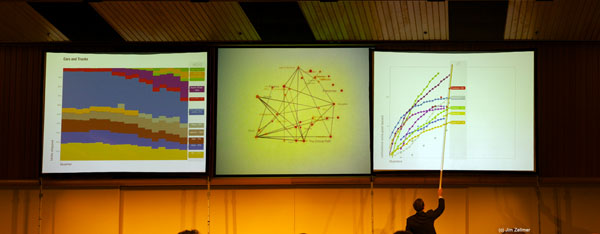Mobile campaigns leveraging location targeting outperformed non-location targeted campaigns by a factor of two times, according to a new report from Verve Mobile.
The Location Powered Mobile Advertising Report found that all location-based strategies exceeded the industry average click-through rate of 0.4 percent, with geo-aware campaigns leading with a one percent click-through average. For the report, Verve reviewed over 2,500 mobile campaigns run across its location-based ad platform in 2012, with the findings reflecting the state of premium location-based mobile ads.
Monthly Archives: February 2013
Iceland: Under the volcano
Einar Már Gudmundsson tells the story of a telephone call he received that morning. His friend told him about a theft the previous night: “It was the first burglary we had heard of in a little shop where all the person took was bread. Not money, nothing else, just bread. He must have been hungry.”
In a land famous for its Sagas, even a tale of stolen bread has resonance, emblematic of the struggles Icelanders now face. For Mr Gudmundsson, a well-known Icelandic author, the burglary adds a human detail to the story of how the Nordic island perched on a volcanic hotspot in the mid-Atlantic has recovered from being one of the earliest and biggest victims of the financial crisis in 2008.
Much has been written about its economic recovery. The island has been held up as a model pupil by the International Monetary Fund, whose help it received in 2008 after the collapse of its three main banks plunged Iceland into a financial maelstrom. Growth may have plunged by more than 10 per cent but it has rebounded in the past two years and industries such as fishing are thriving again. A victory in the Icesave court case has buoyed the national mood.
Nikon Celebrates 80 Years of Nikkor Lenses [Video]
Hotlblack Desiato
I came across the name Hotlblack Desiato when I was driving along Upper Street in Islington, and there it was on a house For Sale sign. It was the name of a new (real) estate agent . I thought it was the most wonderful name I’d ever seen, and wished I could come up with names as good as that.
I couldn’t get the name out of my mind, and when I was trying to figure out the name for the rockstar who was spending a year dead for tax reasons, every name I thought of was not nearly as good as Hotblack Desiato. So in the end I gave up and phoned the agency and spoke – as it happened – to Geoff Hotblack. I asked him if I could use their name and he was, as you might imagine, quite surprised but said I certainly could.
Via Russell Beattie.
“Risk avoidance is a brake on ambition and success.”
The special chemistry of Boeing was one part the men and their originality of thought; one part a kind of corporate innocence that more than once left them outwitted by competitors with sharper elbows and lobbying skills in Washington, D.C.; and one part a stubborn adhesion to a place. Boeing Field resonated with the thunder of their own perfected science, the machines that increasingly became familiar at every airport around the world. This seemed like fulfillment enough: no need to swagger and strut, they seemed to feel; the jets are truly sexy and we own them.
It couldn’t last.
Reaching for a Billion

Horace Dediu (asymco.com, interview) reaches for a billion users at Asymconf Silicon Valley 2013.
The Future According to Google Chairman Eric Schmidt
Anonymity: “Some governments will consider it too risky to have thousands of anonymous, untraceable and unverified citizens — “hidden people”; they’ll want to know who is associated with each online account, and will require verification at a state level, in order to exert control over the virtual world.
Schmidt has had an interesting relationship with privacy questions.
Global Trade: A view from the bridge
For one thing, the airborne share of trade is declining as the efficiency of seaborne trade grows. Los Angeles and Long Beach are spending over $5 billion between them on infrastructure to cope with ever-larger ships. Long Beach is building Middle Harbour, a 321-acre (130-hectare) container terminal that will be able to receive vessels of up to 18,000 TEUs. This month construction began on a replacement for the Gerald Desmond bridge, which will allow larger vessels to penetrate deeper into the harbour.
…….
Other developments may not help the west coast. The much-heralded expansion of the Panama Canal, now postponed until April 2015, will make room for vessels with a capacity of up to 13,000 TEUs (only tiddlers below 4,400 TEUs are now allowed). Over time that could mean a shift of business away from Long Beach to east-coast and Gulf of Mexico ports, though how much will partly depend on the canal’s fees and the capacity of these ports.
Anthony Otto, president of Long Beach Container Terminal, does not sound too concerned. Last year LBCT’s Hong Kong-based parent company placed a big bet on Long Beach’s future by taking out a 40-year, $4.6 billion lease at Middle Harbour. The transit times, facilities and cost structure at Long Beach, says Mr Otto, will ensure it stays the “preferred gateway” to American consumers for many shippers.
But some things the port can do little about. One is the growth of non-traditional trade routes (see article). The China-Brazil connection is increasingly vital. Pascal Lamy, head of the World Trade Organisation, has suggested that Africa could be China’s biggest trade partner within three to five years. Another challenge is “nearshoring”, the shift of manufacturing capacity closer to American consumers (see our special report). Mexico has been the big winner here: since 2010 it has outpaced China in increasing its exports to America. Most goods travel over land: fine news for truckers and trains, less so for ports.